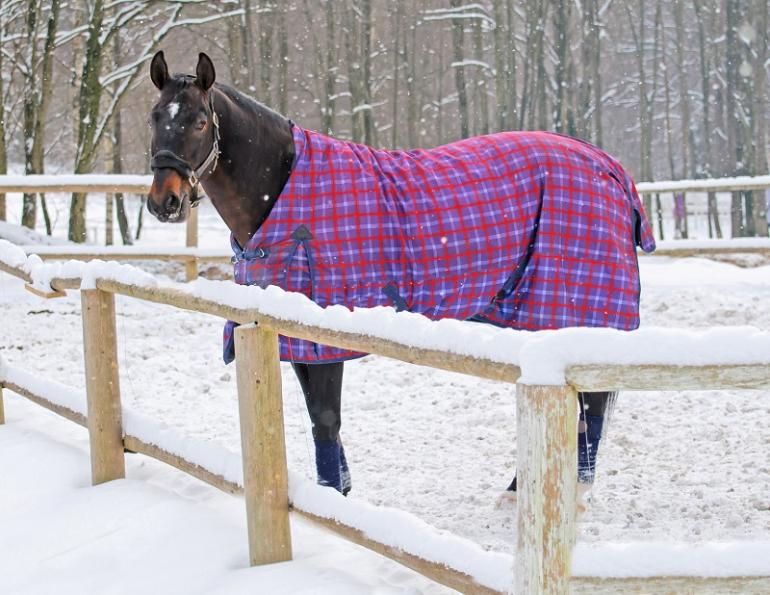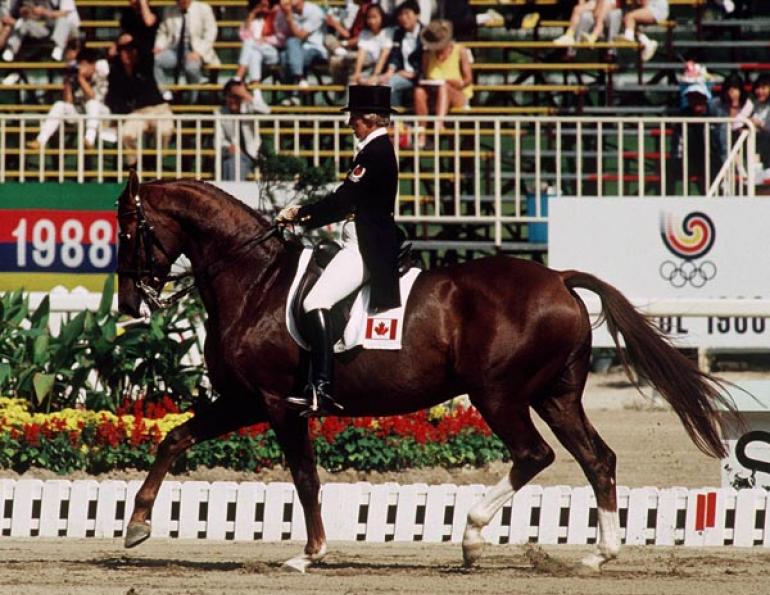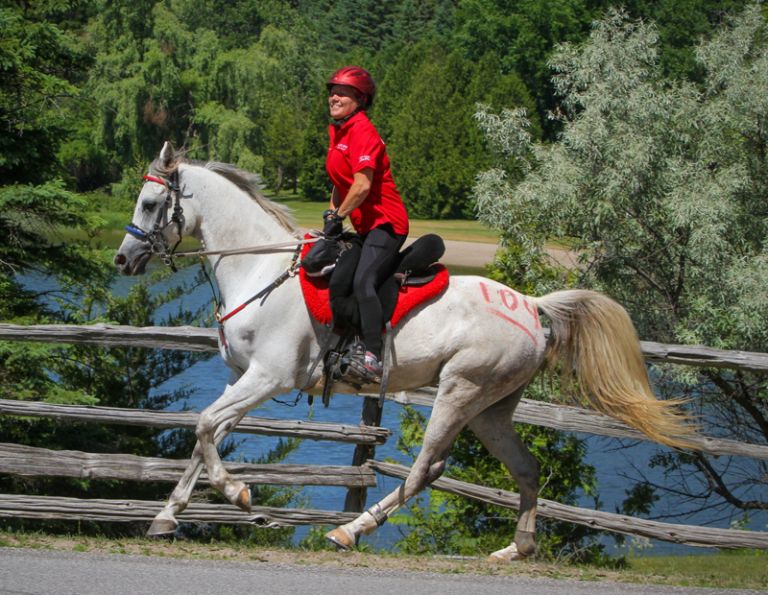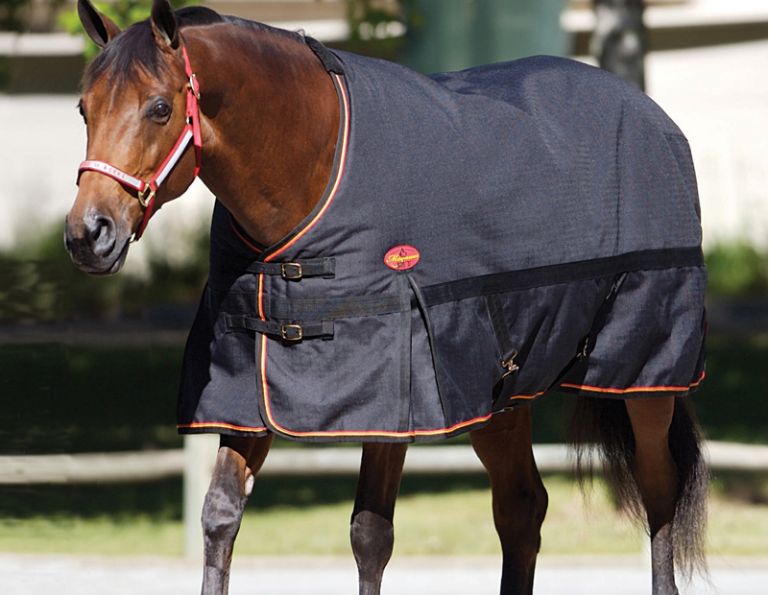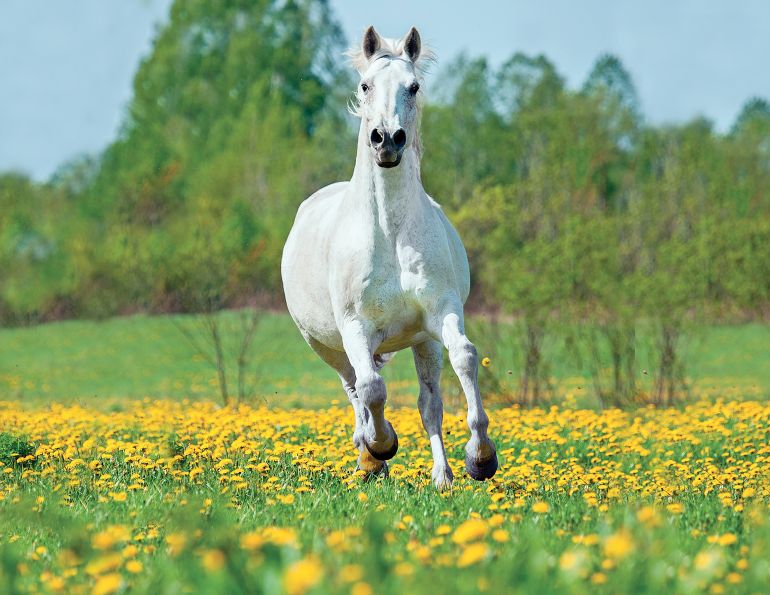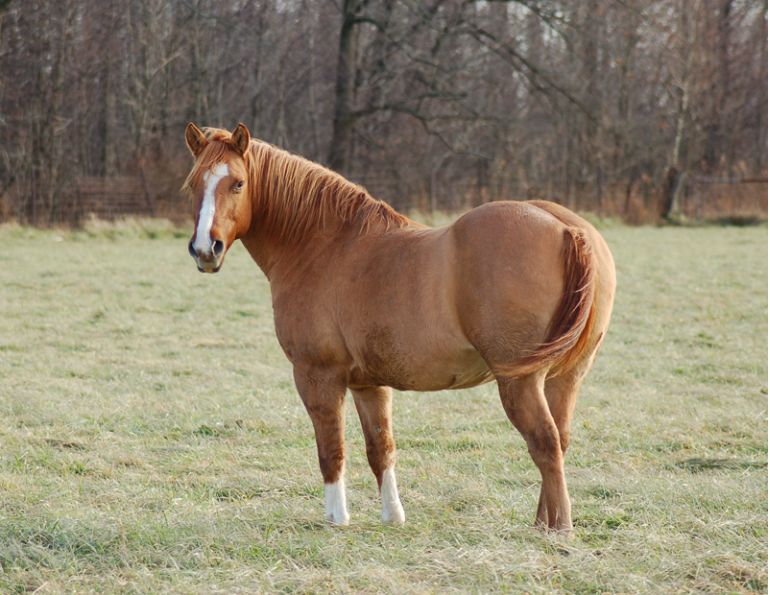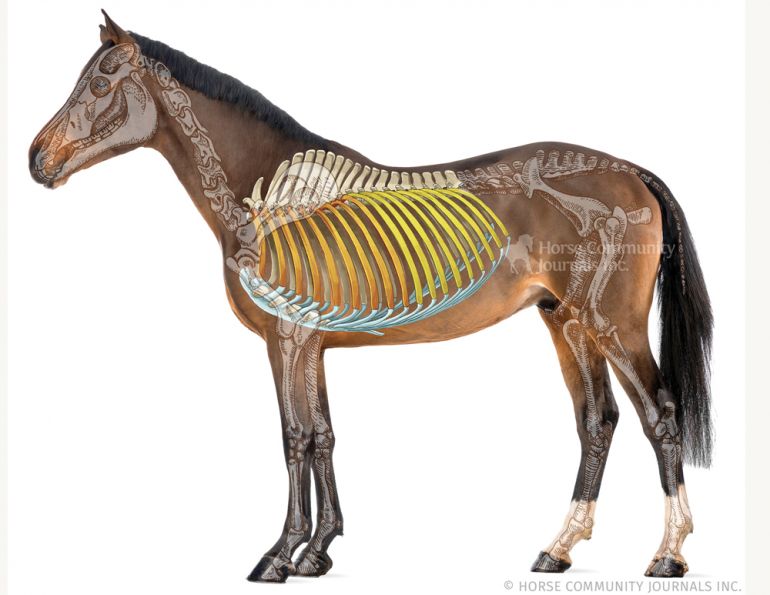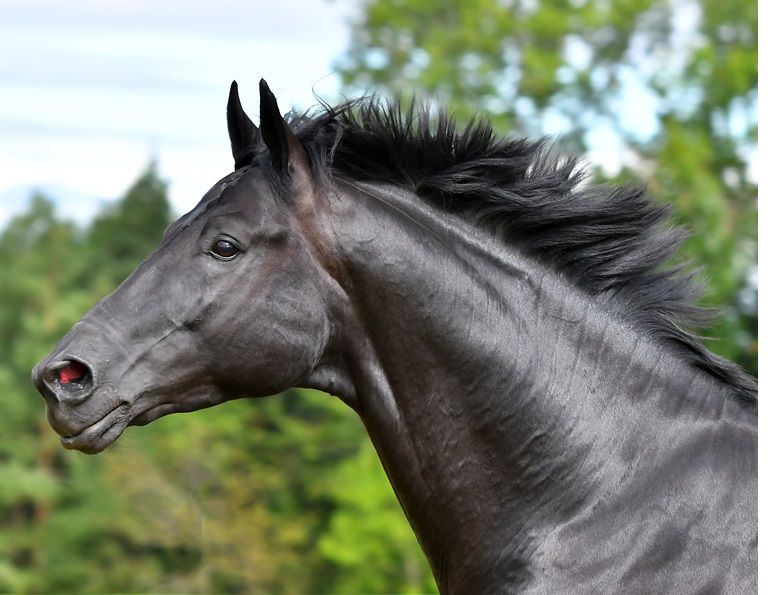By Margaret Evans
Whether or not to blanket a horse is an often-debated question and there are many logical and justifiable reasons to go either way.
In normal weather conditions, many horses do not need a blanket, especially if they have access to food and shelter and have grown a healthy, thick winter coat. But for horses with special needs such as older or geriatric horses, pregnant mares, horses with compromised health conditions, or horses that have been clipped, blankets are certainly appropriate. Consideration should also be given to the horse’s breed, hair coat quality, feeding routine, and its acclimatization to the existing conditions.
Horses have been adapting to the climate for millennia and they still depend on ancestral ways to regulate their own temperature. In the fall, the horse’s coat will start to grow longer and coarser, and its density will thicken. In cold temperatures, this thickness will fluff up with the long guard hairs standing out rather than lying close to the skin. This traps air close to the skin, providing an insulating layer to protect from the cold. It’s sort of like a down jacket. Additional oils accumulate in this thicker coat, especially in pastured horses, providing extra insulation. In addition, horses generate internal heat when they eat hay, so free access to hay or forage add to their ability to regulate their body temperature, while shade and shelter provide protection against the elements.

When temperatures drop, the horse’s long, thick natural hair coat will fluff up to trap air close to the skin, thereby providing an insulating layer against the cold. Photo: Shutterstock/Richard Whitcombe
“People seem to forget that we have only had blankets for horses recently and they have been domesticated for 6,000 years,” says Gayle Ecker, director of Equine Guelph at the University of Guelph, Ontario. “We have to remember that horses have developed their own ways to thermoregulate and we have to respect that. There are certainly times when a blanket will be beneficial to a horse for specific reasons and for specific time periods, but many horses do not need the blanketing that they are given by their owners. In fact, at a recent welfare meeting, there was a presentation on the welfare implications of over-blanketing, and we should take some time to seriously think about our actions. Are we really helping? Or do our interactions interfere?”
Related: How to Blanket a Horse in Cold Weather
All too often, well-meaning horse owners throw on a blanket and it’s there for months. But it may be ill-fitting. It may be too big so it slips around the horse’s back and pulls on the neck. It may be too small with tight strapping that starts rubbing and causing skin abrasions. Or it may be the wrong type of blanket for the weather conditions.
“An ill-fitting blanket could set your horse up for injury,” says Ecker. “Horses get their legs caught in the straps, the blanket can shift and hang down one side which can irritate or spook the horse, or sometimes it encourages other horses to nibble and chew on the blanket which can cause other issues.”
Knowledgeable tack store owners can provide excellent advice on the kind of blanket best suited to specific conditions and the best fit. Deciding to blanket the horse means checking out a host of styles and functions to meet many needs. They include rain and fly sheets, coolers, summer sheets, liners, stable blankets, and an array of turnout blankets. Regardless of style and function, blankets need to be durable to withstand rough horse play, chewing, tugging, rolling, and running around. While some horses are easy on blankets, others definitely are not.
The decision to blanket a horse usually means that several different kinds of blankets may be needed to meet the changing day and night conditions. There is also a rotational need. Every time a dirty, wet blanket is removed for cleaning there needs to be a clean, dry one ready to put on. So, an investment in blankets really means an investment in a wardrobe of them.
“Definitely there are more people blanketing but, with the variables, they really need to look at having a rain sheet or lined rain sheet, a medium weight blanket, and maybe a heavy weight blanket, too,” says Ellen O’Reilly who owns The Horse Habit in Kemble, Ontario. “Know where you horse is in the herd. Is it out by itself? Then a lighter denier will work. Is he the boss horse? Then a medium denier is fine. If he is at the bottom of the pecking order you need a higher count denier or do something like put a Kensington fly sheet over the top to protect it. Also, how much does your horse move around? If your horse moves around and runs a lot, then breathability is a big factor. Ask about the breathability of the denier in the blanket.”
“Denier” refers to the threading of the blanket material and how tightly woven the fabric of the blanket is. The higher the number, the tougher the outer shell. Generally, higher denier blankets tend to have more waterproofing, but that is really dictated by the technology used by the blanket’s design and manufacturing company. A higher denier blanket is a good choice for horses that may be tough on blankets. One made of ballistic nylon is more durable and less likely to tear than one made of, say, polyester.
In terms of weight, a lightweight one such as a sheet has no fill. A medium weight has a moderate amount of fill up to 200 grams. A heavyweight blanket may be up to 400 or more grams of fill. Blankets that have 100 grams of fill may be ideal for horses that are not always blanketed but might need some extra protection on particularly cold days.
Weather conditions are defined not only by temperature but also by the level of humidity. Humidity is the amount of water vapour in the air and this can be an influencing factor on a horse’s comfort level, especially when the wind blows.
Checking out blankets means determining the best fit.
Related: Clipping 101

Healthy horses with a thick hair coat are comfortable in cold temperatures provided they have shelter from wind, snow, and rain. Photo: Dreamstime/Joandawn
“Fit is always a tricky one,” says Samantha Saunders with Summerside Tack & Equestrian Wear in Comox, BC. “I often go out to barns with a variety of styles of blankets to help customers know what to look for when fitting. When deciding on what type of blanket is best for your horse, it is important to keep their conformation in mind. Narrow, high withered horses will fit blankets differently than mutton-withered downhill conformation. I know of smaller Quarter Horses that end up taking an 81-inch simply due to their width and muscling. Perception of fit can be subjective too. It isn’t uncommon for people to think their horse is bigger than it is. I always recommend talking to the staff at their local tack shop to see what they recommend and their experiences with different brands.”
Both Saunders and O’Reilly get asked similar questions by first-time buyers. Both of them have noticed that, given the weather conditions of the past few winters, more customers are blanket shopping. Saunders will ask specific questions about the horse such as age, breed, fitness, metabolism, and their stable environment. The answers help her give advice to the customer on what type of blanket may be the best for their situation.
“I do find I have more customers who are coming in blanket shopping when they haven’t felt the need in the past,” says Saunders. “Especially as we are getting stronger storms and colder winters, like the one in 2016-2017. For those who are only just starting to blanket, I always recommend [a blanket of] at least 100 grams which would be a lightweight blanket. As for rain sheets, they will flatten the hair and not allow the horse to properly insulate. They will make them colder during our damp, cold December storms. The 100 gram [blanket] is the perfect weight for those who only blanket during worst weather.”
Buying a blanket that fits properly means taking the proper measurements. If you already have a blanket that fits well but it’s getting old or you want to complement it with other variable style blankets, then O’Reilly suggests keeping to that blanket line. Every line has a good, better, and best blanket, she says.
Related: How to Waterproof Horse Blankets
“Measuring from the centre of the chest to the side of the tail gives a good basic size to work with,” says O’Reilly. “Also know whether your horse fits a Quarter Horse-type blanket or a more European-type blanket - this is very noticeable in the sizes 74 to 76 range. Possibly 50 percent of horses fall in that range. European styles are usually every 3 inches and just don’t work well on some horses in that size range. It is also a good idea to measure the top of the back from the withers to the top of the tail. Also, if you have a blanket that fits well, bring it in and size the other blankets with it. Having a couple of pictures of your horse from the side also helps. Especially on mares, make sure the blanket isn’t too big - you want the seam at the top of the tail flap at the top of her tail.”
To properly measure for a blanket, have someone hold the horse on level ground. Using a flexible cloth tape, hold it at the centre of the chest. Keeping it level and tight, measure around the widest part of the shoulder, along the barrel to the widest part of the hindquarter and around to the tail. Whatever that length is from chest to tail – say 76 inches – is the blanket size for your horse. If the length is an odd number, go up to the next higher even number. However, blankets fit differently and your horse’s breed and build will be deciding factors on the exact size.
Given the challenges of wetter or snowier winters, waterproofing is a big issue. In recent years there have been advancements in the waterproofing qualities that customers constantly look for.
“[Some blanket designs] allow the blanket to keep the breathability and allow sweat to evaporate while still being waterproof on top,” says Saunders. “This is incredibly important for our customers on the wet west coast. As for design, there are always new ideas coming to market. However, I find the tried and true classic cuts always hold their value and are dependable.”
When we make the decision to blanket our horses, how do we know they appreciate the effort? Well, what if they could tell you?
Just as in North America, blanketing horses in the Nordic countries is very common, but it is a still-disputed management routine.
In 2013, a study was conducted by researchers with various agencies including the Norwegian Veterinary Institute, Norwegian Institute of Life Sciences, Norwegian Institute of Bioeconomy Research, and Trondheim Hundeskole. The aim of the study following initial training was that each horse, when placed in a free choice situation, would be able to communicate whether it wanted a blanket put on, taken off, or stay unchanged. The importance of the free choice level signalled that the horse had not only learned the criteria but understood that it had options and consequences unique to its own idea of comfort.
Twenty-three horses of varying ages and breeds including 13 cold-blood and 10 warmblood horses were selected. All were riding horses living on neighbouring properties in mid-Norway and they were used for dressage, jumping, and recreational riding. A few were also carriage horses. The average age was 10. All were accustomed to wearing a blanket according to the preferences of the owners. Some wore a blanket consistently while others were only blanketed when the weather was extreme.
The horses were trained to recognize three symbols painted on white, wooden display boards. One board had a black horizontal bar meaning “put blanket on.” One was plain white with nothing on it meaning no change. And one was a white board with a black vertical bar meaning “take blanket off.”
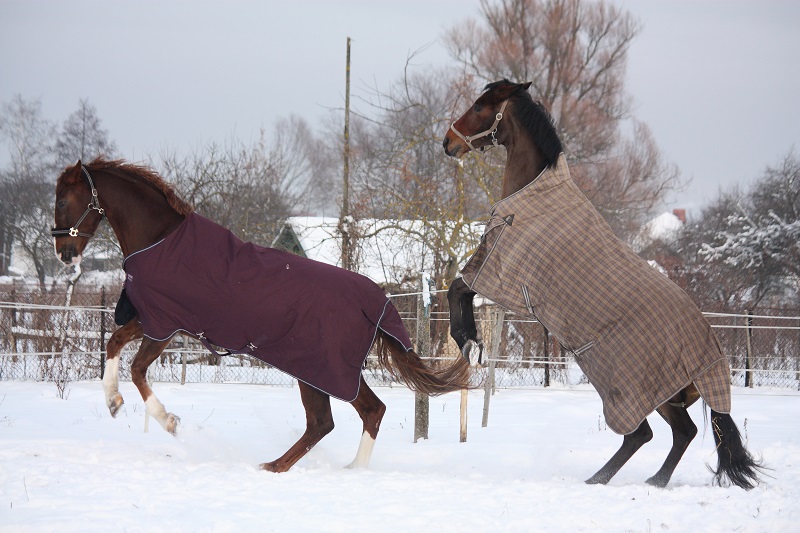
Blankets should stay in place during vigorous activity and allow for complete freedom of movement. Photo: Shutterstock/Anastasija Popova
Training was conducted in January 2013 and fall 2013 for temperature variations. It was a ten-step process starting with each horse learning to approach and touch the board with its muzzle in return for sliced carrot treats. The training advanced to teaching each of them to distinguish between the blanket-on and blanket-off symbols and how that related to their own thermal comfort. When a horse pointed to the blanket-on board, a blanket was put on it, and vice versa if the horse pointed to the blanket-off board.
Within 14 training days, all 23 horses grasped the meaning of the symbols and responded to them, communicating they understood that the symbol of choice would result in an outcome that would affect their own comfort. They learned it so well that, when advancing to the free choice tests with the boards attached to paddock fences, they participated with their choices correlating their desire to be blanketed, or not, according to the weather.
Related: How to Weight Your Horse Blanket Options
The research provided valuable information on a horse’s cognition and learning ability. The study was published in 2016 in the journal Applied Animal Behaviour Science.
Horses are highly adept at responding to changing conditions in their immediate surroundings. Years ago, we owned a Palomino mare, Zona, who was herd leader. The horses were not usually blanketed, although in her aging years Zona wore one. When the wind really picked up, she would lead the others to a very precise spot just off-centre from the middle of the field and not far from some old, unused barns. Even when the wind howled, this wide-open spot had little wind as the nearby barns disrupted the wind’s strength and direction. Even though Zona has long since passed away, the horses in her company retained that memory of reading the wind. They passed that knowledge down through the generations of horses we still own, and stand in the same spot when the wind blows.
Whether or not to blanket should be decided based on some important criteria starting with a good body conditioning score (BCS). The Henneke Body Scoring System is based on a scale of 1-9 with 1-4 being in poor or thin condition. A horse in good condition will score from 5 to 6 while horses with excess fat will be in the 7-9 range.
“A healthy horse in good BCS (5-7) with a good winter coat, and with a place to get out of sleet, freezing rain, and cold winds may not need a blanket at all over the winter,” says Ecker. “Horses that are not growing a winter coat, or that are clipped or fall into the vulnerable categories (BCS 4 or lower, illness, limited mobility, etc.) may benefit from a winter blanket. But before buying, try feeding more hay first (add 10 to 15 percent on very cold/windchill days) as the ‘furnace’ of digestion is often enough to keep them sufficiently warm and they will often move around a lot more to help keep warm by exercise.”
Ecker says, if you decide to blanket remember that you need to monitor the weather throughout the day and during the season.
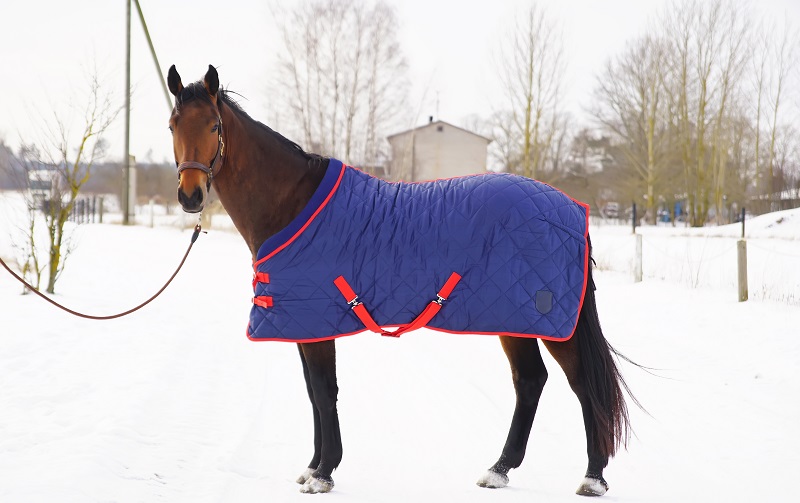
The clipped horse will need the warmth provided by a blanket, as will those with special needs such as the sick, elderly, or thin horse. Photo: Shutterstock/Eudyptula
“There are far too many examples of inappropriate blanketing such as a heavy winter blanket that is left on the horse whether it is night or day, or if the horse is standing in the sunshine and the day has warmed up but the heavy blanket is still left on and now the horse is overheating,” she says. “The horse is sweating for hours during the day (which may not be noticed by absentee or inattentive caretakers) and now the inside of the blanket is wet. Nighttime comes with dropping temperatures and now the horse is standing in a wet blanket with dropping temperatures and this sets the horse up to be easily chilled during a time when no one is watching. Signs to watch for in winter that could signal the need for a blanket include shivering, weight loss, unusual appetite and aggressiveness for food, and huddling with other horses.
“If we choose to blanket our horses, we must be prepared to thoughtfully use the blanket as needed and monitor the warmth of the horse (by feeling not only the chest under the blanket but also under the lower abdomen to get a true sense of inner body heat). We need to realize that the blanket needed for nighttime cold weather will be different than a blanket suited for higher temperatures during the day, if in fact needed at all.”
Daily inspections should be done for injury, entanglement, blanket damage, and the horse’s comfort level. Weekly inspections cover any changes to the horse’s condition or blanket fit.
Some horse owners may be too casual about blanketing and not check the horse frequently.
Related: Winter Water for Horses
A neighbour of mine had his horses blanketed during the winter. One of them, though, had been standing by our fence line too long. No one had come looking for him. On checking, I found that his belly strap was undone and had somehow become hooked to the wire fence. He was stuck. Once freed, he trotted off happily to rejoin his buddies. Luckily, he was a quiet guy and hadn’t panicked at being alone.
It is wise to keep a regular check on a horse’s behaviour when rugged. There are times when horses may be trying to remove the blanket by rolling or biting at it, but cannot remove it. A horse may be turned out with a fly sheet or a rain sheet, which may keep flies off and rain out but not let the heat escape, causing the horse discomfort as it overheats. Horses turned out in a group may have their social interactions such as grooming compromised because of a blanket. The desire to groom, which is driven by a strong social bonding emotion, can result in damaged and torn blankets.
If a broodmare is turned out with a nursing foal, she should not be blanketed. It is far wiser to allow the foal to freely nurse than risk its head getting caught up in a leg strap and the mare panicking. I recall being told of one owner insisting her mare give birth while still being blanketed. Really? Apart from the obvious overheating she’s going to suffer, the potential hazards to the foal are unbelievable.
“Sadly, some boarding facilities have unrealistic blanketing policies where they will put a blanket on in late fall but not remove and check it daily until the ‘blanket removal date’ in the spring,” says Ecker. “This is not in the best interests of your horse, so you need to carefully consider if this is the right place for your horse. Checking and removing blankets daily is a time challenge for boarding facilities, but such a policy is for convenience and not for the health and welfare of the horse.

Photos: Canstock/Grase
“Leaving the blanket on for weeks at a time prevents you from checking the BCS of your horse. If the horse is gaining or losing weight, this will be missed. There are some owners who have had a rude shock in the spring [due to] a big change in the BCS during the last few months. An obese horse will not need the blanket and can benefit from using those extra stored calories to burn up body heat. A thin horse may have a health issue underlying the weight loss which has not been noticed for weeks, or it may need an increase/change in feed to maintain its weight at a healthy level. Prolonged blanketing may prevent you from effectively monitoring your horse and that can lead to welfare issues.”
Working with blankets means keeping the wardrobe in good repair. When repairing a torn blanket with a waterproof outer shell, do not attempt to sew it as this will compromise the waterproofing. And duct tape doesn’t cut it. Have the blanket professionally repaired.
Some blankets, such as sheets, can be machine washed at home but double-check the capacity of your washer and its specifications. Brush off excess dirt and mud with a stiff brush and scrape off any hair to avoid plugging up the plumbing. Place the blanket in a large mesh bag to contain all straps and fasteners and protect your machine from damage. Machine wash in cool water on a gentle cycle using a very mild soap. Be sure it is thoroughly rinsed as some soaps can irritate the skin. Avoid detergents and fabric softeners. Line-dry the blanket or lay it over a rack.
Related: Does My Horse Need Electrolytes in Winter?
For heavier blankets, source a local professional laundry service that offers horse blanket services but be sure to do the basic cleaning first.
In winter the challenge is to get a wet blanket clean and dry before it needs to be put back on the horse. In the average tack room there are only so many hooks for hanging up blankets, so a blanket rack is a great addition, especially when several rotating blankets are needed.
Maintaining the waterproofing quality requires care. According to Equine Guelph’s resource site, the Horse Blanketing Tool, all modern blankets have a permanent membrane on the inside surface of the outer blanket shell. “A separate waterproofing wash is applied to the outside surface of the outer shell to protect it from absorbing water. This waterproofing wash is either a silicone or a PTFE (Teflon) and has a limited life and will need reproofing. The usual practice is to have the blanket washed and repaired annually (if necessary) and then reproofed before the start of the next season of use.”
Investing in blankets is done over time and maintaining them well protects that investment. A blanket in need of repair calls for immediate attention. Gaping holes can be a hazard, not only should the horse get its hoof caught when rolling, but if a paddock-mate or foal becomes entangled. Make a habit of regularly checking stitching, fasteners, and belly/leg straps. At the end of winter blanket season, have blankets cleaned and repaired as necessary before storing, ideally in a warm and dry location away from rodents that will use it as a bathroom or tear off segments for their own nests. If a blanket needs replacing, try to capitalize on deals as they come along, including checking out good, used blankets.
“When budget is an issue, I always recommend trying to find the best value,” says Saunders. “Do your own research on what brand is going to work best for your needs. Shop sales, purchase blankets in the off-season. But I find when people try to save too much and go too cheap, the blanket ends up needing repairs faster and doesn’t stay waterproof for as long, which ends up costing more in the long run.”
Related: Winter TLC for Horses with Arthritis
Related: Winter Management for your Outdoor Horse
Main photo: Shutterstock/Natalya Rozhkova



